A version of this article originally appeared on Pinkbike.
What do you look for in a helmet? Price, style, weight, ventilation and comfort are all important considerations, but the main purpose of a helmet is to keep your head safe when it hits the dirt. One piece of advice you’ll often hear is to buy the best one you can afford. But are more expensive options any safer? And do anti-rotation inserts like MIPS reduce the risk of concussion? Do mountain bike helmets protect your head better than road helmets?
If you want to know how good a helmet is at cushioning your brain, it’s not a good idea to experiment on yourself. Fortunately, the engineering department at Virginia Tech has a state-of-the-art, independent helmet testing lab. They’ve been testing all sorts of sports helmets since 2011 and have put 235 cycling helmets including 73 mountain bike lids through their repeatable but realistic testing protocol.
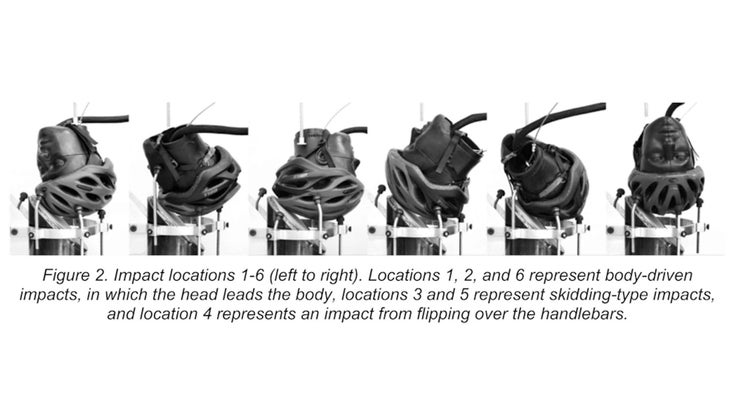
How are they tested?
Virginia Tech has developed a test that’s specific to cycling helmets. You can read the full details here but the basic version is that each tester is fitted onto a standard dummy “head” complete with acceleration and rotation sensors. The helmet is then dropped onto a hard surface such that it strikes it at six different impact locations around it. This is done at two different impact speeds (4.8 and 7.3 meters per second, or 17.3 and 26.3 kph). The lower speed is designed to replicate the most common impact speeds seen in the real world and the second is the most likely speed that results in concussion—these numbers are derived from helmets that had been recovered from real-world crashes.
This is repeated twice, resulting in 24 test impacts for each model. For each test, the linear acceleration and rotational velocity of the dummy head are measured, and an algorithm is used to convert these numbers into an overall score. The scoring system uses the rotation and acceleration measurements to estimate the risk of concussion for each impact, then these results are weighted depending on how common each type of impact occurs during real-world cycling. This produces a single score that is proportional to the overall risk of concussion during cycling.
The lower the score, the lower the chance of concussion.
Any score below 14 gets a five-star rating. A model has to score below 19 to get four stars and be considered recommendable by Virginia Tech.
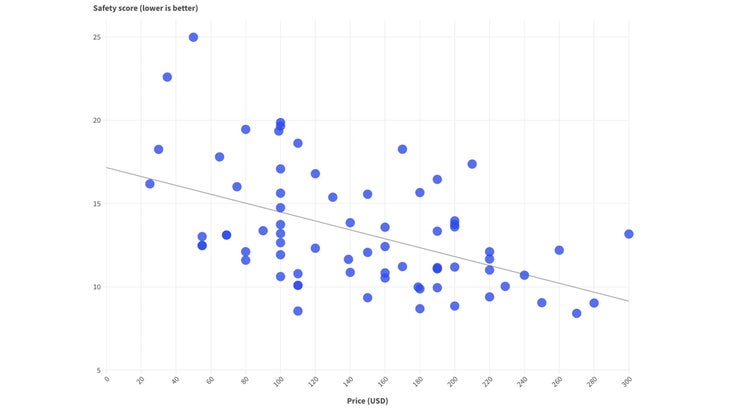
Are More Expensive Mountain-Bike Helmets Safer?
Sort of.
Of the four helmets costing $50 or less, none got close to a five-star rating (a score below 14); of the sixteen models costing $200 or more, all but one got five stars. All of the helmets that cost more than $100 received at least four stars (scored below 19), making them at least worthy of consideration according to Virginia Tech.
More expensive options tend to be safer on average, but there’s a lot of variation and many outliers as you can see in the scatter chart.
So the old maxim that you should spring for the best helmet you can afford isn’t a bad rule of thumb, but if you start with the data from Virginia Tech you can pick a very safe model without spending too much.
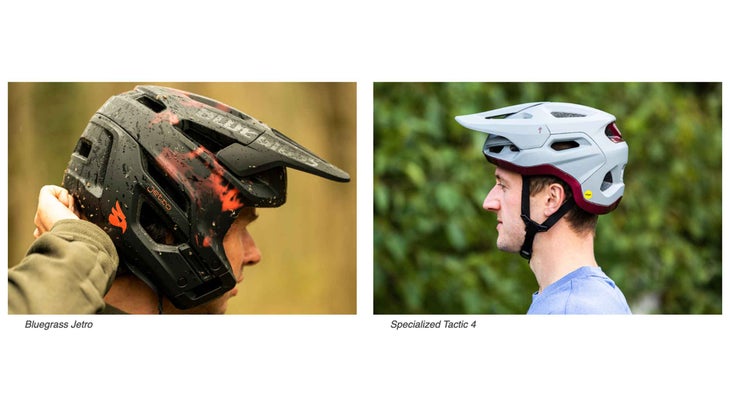
Which Helmets Stand Out?
The safest mountain-bike helmet tested so far is the Bluegrass Jetro, a three-quarter style version which scored 8.41 and costs $270. But the biggest outlier on the price-to-safety spectrum is the Specialized Tactic 4, which scored 8.55 and costs just $110. Based on Virginia Tech’s testing, that’s the model I’d suggest if the style and fit suit your needs.
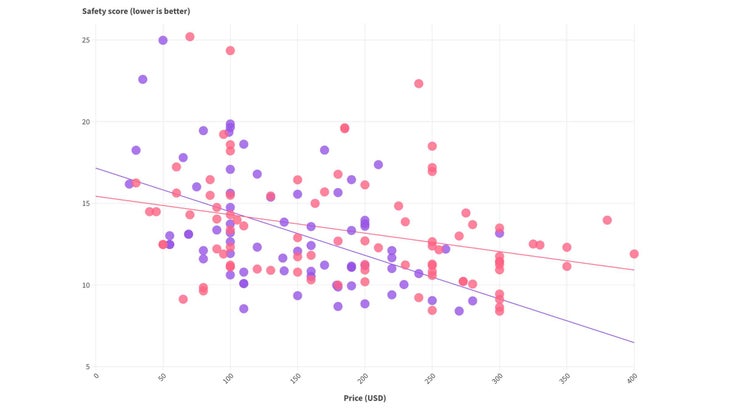
Are Mountain-Bike Helmets Safer than Road Options?
Not really.
Some of the best (lowest scoring) models tested by Virginia Tech are road helmets, as are some of the worst, which could reflect the fact that more road versions have been tested. Looking at the scatter chart above, there is an even weaker relationship between cost and safety in the road world, perhaps because high-end road helmets are chasing aerodynamics more than impact absorption.
Impressively, three road models costing $80 or less scored below a 10. Chapeau to Giant, Lazer and Specialized for those.
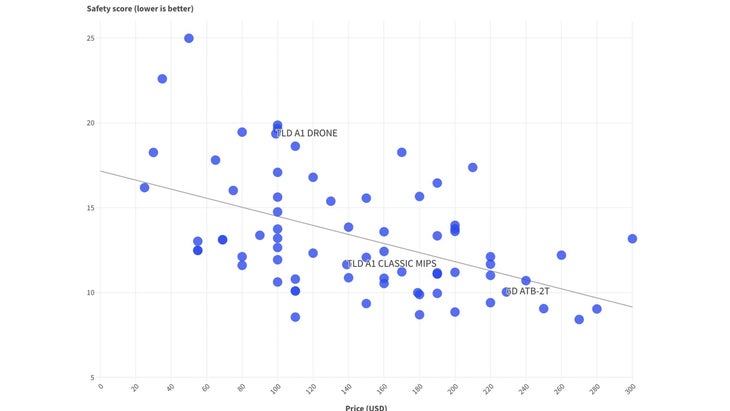
Are MIPS Helmets Safer?
According to this data, yes.
The lowest-scoring (safest) mountain-bike helmet without MIPS is the beautifully named 6D ATB-2T, which scored 10.03, putting it in 12th place for mountain bikes. It has a conceptually similar technology called Omni-Directional Suspension (ODS). The next best is the POC Tectal Race SPIN, which ranked 29th and scored 11.67. It too has a similar technology called SPIN (Shearing Pad Inside), which POC has since phased out in favour of MIPS.
So, the 11 best-scoring mountain-bike helmets all have MIPS; only two of the best thirty don’t have MIPS, and both of them have something similar.
However, the vast majority of the models on test have MIPS, especially the more expensive ones, so this isn’t as surprising as it sounds. Even so, the nine poorest-performing mountain-bike helmets all lack MIPS, and five of those cost $99 or more.
Also, the Troy Lee A1 Classic MIPS scored a respectable 11.65, while the MIPS-free Troy Lee A1 Drone scored a damning 19.35.
Some have suggested that the benefit of a MIPS liner may diminished in the real world because the rider’s hair (for those who have it) creates its own slip plane which does a similar job. But even if a thick head of hair can allow the helmet to rotate relative to the skull, that’s not to say it works as well as a MIPS liner, especially in combination with hair. According to MIPS, hair isn’t as slippery as you think once the G-forces are pressing your head into your helmet during a crash, whereas MIPS liners are designed to slide even under these huge compressive loads.
Besides, even if all that MIPS achieved was to improve outcomes for the bald, it would still be worth helmet manufacturers using it.
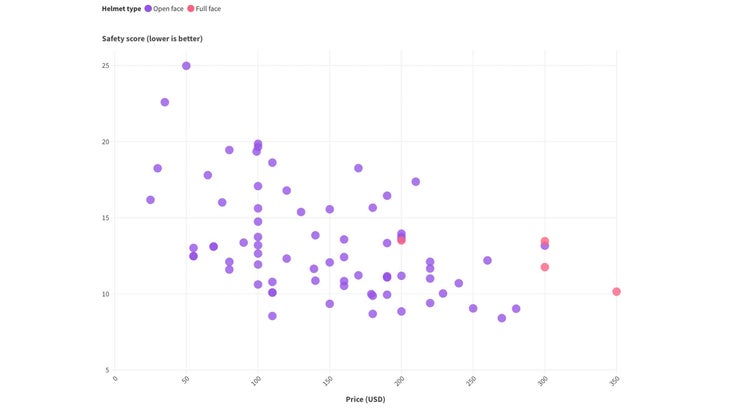
Are Full-Face Options Safer?
It’s not clear.
Virginia Tech isn’t testing face-on (chin bar) impacts, where full-face helmets obviously have an advantage. If you’re likely to land on your face, best to wear a full-face helmet. But when tested in the same way as open-face helmets, using the same six impact locations, the full-face helmets don’t score better. This is perhaps surprising given they are designed for downhill and enduro use, including racing.
Virginia Tech has only tested four full-face helmets so far, which isn’t enough to make broad conclusions, but they don’t stand out as you might expect—the best full-face helmet (Bluegrass Vanguard) ranks 15th among mountain-bike helmets. Having said that, all four received five stars (scored less than 14), and the average score was 12.2, slightly better than open-face mountain-bike helmets, which averaged 13.3. We would need more data to know if full-face helmets generally do better or worse on Virginia Tech’s test procedure, but the four tested so far are merely midpack.
So while full-faces offer better coverage, they’re not necessarily offering better protection when tested on the same impact locations.

Limitations and Conclusions
It’s worth underlining that Virginia Tech haven’t tested every helmet on the market and some on their database are older than others, so it’s probably not fair to make general comparisons between brands or to say that the best they’ve tested is the best there is.
As with any laboratory test, there is a tradeoff between repeatability and realism. Virginia Tech can’t simulate every type of crash, impact speed or head shape. A different test with different variables might come up with different rankings, but Virginia Tech’s is probably the best independent data that’s publicly available. How a helmet fits your unique head is important for safety as well as comfort so it’s a good idea to try a few helmets on in a real-life bike shop, then pick one that scores well and fits well.
